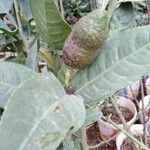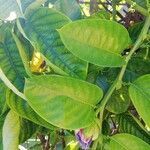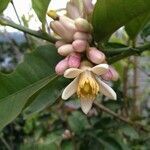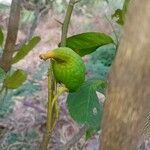| Therapeutic use
|
Antineoplastic agents (aerial part), Acne vulgaris (bark), Freckles (bark), Skin care (bark), Abdominal pain (flower), Anorexia (flower), Appetite stimulants (flower), Asthma (flower), Astringents (flower), Cough (flower), Hiccup (flower), Neoplasms (flower), General tonic for rejuvenation (flower), Scorpion stings (flower), Vomiting (flower), Abdominal pain (fruit), Alcoholism (fruit), Hair loss (fruit), Amenorrhea (fruit), Analgesics (fruit), Anorexia (fruit), Anthelmintics (fruit), Anti-bacterial agents (fruit), Antifungal agents (fruit), Appetite stimulants (fruit), Asthma (fruit), Astringents (fruit), Bronchitis (fruit), Calculi (fruit), Cardiotonic agents (fruit), Colic (fruit), Constipation (fruit), Cough (fruit), Dandruff (fruit), Diarrhea (fruit), Digestive system diseases (fruit), Dizziness (fruit), Dysentery (fruit), Dysmenorrhea (fruit), Dyspepsia (fruit), Dyspnea (fruit), Earache (fruit), Emollients (fruit), Fever (fruit), Flatulence (fruit), Headache (fruit), Heart diseases (fruit), Hemoptysis (fruit), Hemorrhage (fruit), Hemostasis (fruit), Hiccup (fruit), Hypotension (fruit), Jaundice (fruit), Kidney diseases (fruit), Leprosy (fruit), Liver diseases (fruit), Malaria (fruit), Menstruation-inducing agents (fruit), Mental disorders (fruit), Nail diseases (fruit), Pain (fruit), General tonic for rejuvenation (fruit), Scurvy (fruit), Skin diseases (fruit), Sunstroke (fruit), Thirst (fruit), Urination disorders (fruit), Urologic diseases (fruit), Vomiting (fruit), Whooping cough (fruit), Cooling effect on body (fruit), Analgesics (leaf), Anthelmintics (leaf), Antifungal agents (leaf), Diarrhea (leaf), Insecticides (leaf), Pain (leaf), Vomiting (leaf), Abortifacient agents (root), Anthelmintics (root), Antiemetics (root), Colic (root), Constipation (root), Dental caries (root), Diuretics (root), Flatulence (root), Helminthiasis (root), Hemorrhoids (root), Insecticides (root), Jaundice (root), Laxatives (root), Neoplasms (root), Stomach ulcer (root), Urinary bladder calculi (root), Urinary calculi (root), Urination disorders (root), Vomiting (root), Amenorrhea (seed), Anti-inflammatory agents (seed), Cardiotonic agents (seed), Contraceptive agents (seed), Dysmenorrhea (seed), Edema (seed), Fertility agents (seed), Heart diseases (seed), Hemorrhage (seed), Insecticides (seed), Menstruation-inducing agents (seed), Nausea (seed), General tonic for rejuvenation (seed), Scorpion stings (seed), Skin diseases (seed), Typhoid fever (seed), Hair loss (stem), Astringents (stem), Dandruff (stem), Insecticides (stem), General tonic for rejuvenation (stem), Aperient (unspecified), Arthritis (unspecified), Astringent (unspecified), Cough (unspecified), Diarrhea (unspecified), Dysentery (unspecified), Expectorant (unspecified), Fever (unspecified), Headache (unspecified), Insanity (unspecified), Jaundice (unspecified), Nausea (unspecified), Pectoral (unspecified), Refrigerant (unspecified), Rigerant (unspecified), Stimulant (unspecified), Ache(Stomach) (unspecified), Syphilis (unspecified), Thirst (unspecified), Tumor(Abdomen) (unspecified), Sclerosis(Spleen) (unspecified), Colic (unspecified), Stomachic (unspecified), Tonic (unspecified), Abdominal pain (unspecified), Anthelmintics (unspecified), Antiemetics (unspecified), Appetite stimulants (unspecified), Asthma (unspecified), Astringents (unspecified), Brain diseases (unspecified), Cardiotonic agents (unspecified), Cardiovascular diseases (unspecified), Cholera (unspecified), Common cold (unspecified), Constipation (unspecified), Digestive system diseases (unspecified), Dyspepsia (unspecified), Flatulence (unspecified), Hematologic diseases (unspecified), Hemorrhoids (unspecified), Hiccup (unspecified), Low back pain (unspecified), Malaria (unspecified), Menstruation disturbances (unspecified), General tonic for rejuvenation (unspecified), Sciatica (unspecified), Urinary calculi (unspecified), Vomiting (unspecified), Cooling effect on body (unspecified), Anti-infective agents (whole plant)
|









